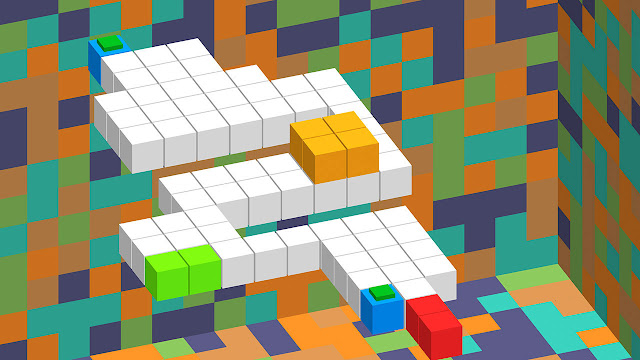Puzzle Video Games, Cubed: Breezeblox, Rush and Edge
Being a fan of video games for as long as I can remember, I'm somewhat surprised over how my gaming preferences have changed over time. I've previously gravitated towards more complex and graphically sophisticated games in order to experience the latest advancements in gaming technology. Yet as my real life becomes more stressful and personal funds get smaller, I find myself going back to the basics: simple yet intriguing visuals matched with simple yet addictive game play. This post will look at three indie puzzle games that caught my attention--Breezeblox by Brennan Maddox, and Rush and Edge by Two Tribes--and why they're the go-to games for unwinding when reality causes your brain to overheat.
Breezeblox, Rush and Edge are puzzle games that focus on geometric shapes, spatial relations and limited movement. There are no end bosses to beat, weapons to find, or enemies to vaporize; these games are all about navigating movable cubes from one end of a platform environment to another. While this sounds simple in concept, each game presents unique challanges to an otherwise simple premise.
Breezeblox is the simplest of the set, although that doesn't mean it's easy. Players navigate a set of four orange cubes that are arranged into a rectagular box from one point of a tiled platform to another. Because of the cubes' shape, players can only move in four directions--forwards, backwards, left and right--with no options to move diagonally. The titles on the platform match the dimensions of the cubes and depending on how you move the four cubes, they can either stand on two tiles at a time or lay on four. The movement of the cubes have to match the dimensions of the platforms in order to make it to the end tiles; for example, if the end tiles consist of only two tiles, then players have to move the cubes to that only two cubes are standing on the end tiles to finish the level. The more advanced platforms include buttons that have to be pressed in order to progress to the end of the platform.
In contrast to Breezeblox, the multi-colored cubes in Rush move on their own across tiled platforms. Players are tasked with placing the a limited number of navigation icons on the tiles (e.g., arrows, stop signs, conveyor belts and rotating sorters) to make sure that each cube type makes it to its appropriate destination without falling off the platform or running into other cubes. The cubes move forward by default; when they hit an object, they turn right, so players have to consider this when arranging the icons on the platform.
Edge combines aspects of both Breezeblox and Rush. Like Breezeblox, players navigate a cube across tiled platforms; like Rush, players will frequently encounter tiles, walls and other cubes that move on their own in a mechanical, factory-like manner. By combining these aspects, Edge is more challenging than the other two games and is much closer to a standard 3D platforming game, albeit without the usual 3D platforming options such as jumping and moving diagonally.
I've enjoyed each of these games, although I'm still amazed at how such interesting games can be made with nothing more than simple graphics, slick presentation and basic game play. In some ways, they remind me of the bit Generations and Art Style games from past Nintendo consoles, both of which utilized the same approach. I'm sure that as computational power increases in the years to come, video games will continue to expand in terms of complexity and immersion. Nevertheless, I'm glad that simple and challenging and fun games like Breezebox, Rush and Edge are still around for when life itself becomes too complex for one's stress levels.







Comments
Post a Comment